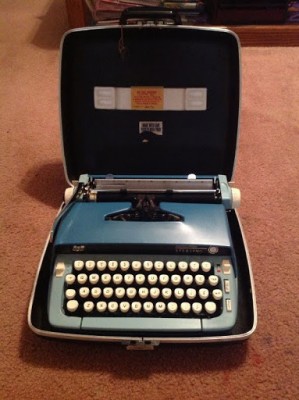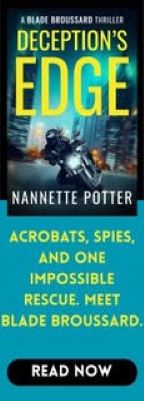by Kristalyn Patzkowski
According to the Oxford Dictionary, technology is “the application of scientific knowledge for practical purposes, especially in industry.” In the modern world, the word “industry” is so closely linked to computers that we assume that technology is limited to computers as well. However, the oxford dictionary expands the definition so nearly every invention in history can be considered a technology. Such an invention would be the typewriter, which has been surpassed by the computer industry, but it has managed to create a legacy of its own.
Before I owned a computer or even knew that they existed, I knew of typewriters. When I was young, I was wandering around the library at home and I found a large blue case. I asked my mom to open it up, and she revealed the most beautiful invention that I had ever seen up until that point. I could clearly see the ebony letters printed on the off-white keys, and the dusty levers behind each row of buttons. As I pushed the letter K, the carriage moved slightly and I observed one of the levers puncture the air. My mom explained that the typewriter was an innovation used for manual printing and that you’re supposed to place paper behind the carriage. This explanation seemed satisfactory, and this is probably the first moment when I realized that I wanted to write.
While the typewriter is intended for personal use, the actual creation and patenting took time. In 1714, Henry Mill took out a patent in England for the first typewriter, but he didn’t make much progress on the actual machine (Typewriter). In an article in the Columbia Electronic Encyclopedia, it is written that in 1829, William Austin Burt patented a new topography machine in the United States. His writing machine could not be considered a success though, because it was primarily used for the blind and it produced only embossed writing. Other than that, there was no other practical purpose. Thirty-eight years later, in 1867, Christopher Latham Sholes tinkered his way to a solution. Darryl Rehrer writes that “Along with his associates, Carlos Glidden and Samuel Soulé, Sholes created the first typewriter.” Their first model, which was manufactured by Philo Remington, the gun company, had only capital letters, and it appeared in markets in 1874 (Rehrer). Four years later, a new model featured a shift key and allowed for the change of case.
Within the next century, many newer models came out, changing the number of rows and surfaces of the paper holders, including interchangeable globes that allowed for a variety of typefaces and special characters, and finally, updating the globes to a daisy wheel, which spun the type into proper position. Such changes were made by the International Business Machines (IBM) and made typewriters profitable inventions.
Typewriters may be considered the ancestors of computers and this is due to the QWERTY keyboard. The name derives from the first six letters, from left to right, in the top row of letter keys. A debate that has come from this arrangement of keys is that Sholes was trying to slow down quick typists, to prevent jamming up the complex machine. This was a rumor, but there is truth in the fact that Sholes wanted to prevent the jamming of keys on his typewriter. For this reason, he created a few letter pairs, such as TH and ED. Now, no keys were adjacent and type bars could be activated one after another. Jamming still occurred, but it happened less frequently than before.
Christopher Latham Sholes’ invention also reached infamy through famous owners of his machine. Fanny Kemble, a Victorian actress and writer bought a Sholes & Glidden typewriter and she used it to write a copy of Col-Tram for Atlantic Monthly. She holds the title as the first writer to use a typewriter. A more famous writer also took interest in the machine. After seeing a typewriter for the first time, Mark Twain bought his own typewriter. Sources have said that Twain was entertained by the device and never ended up using it for his professional works. In fact, he hired typists to transcribe his manuscripts. However, Twain did become known as the first author to send a novel to a publisher in typed form, with the novel Life on the Mississippi in 1883.
Very few people in modern society still own typewriters, but Sholes’ invention is still in existence. For instance, you can buy a typewriter for as little as thirty dollars in some stores. What’s more is the typewriter has left behind a legacy. In this age of technology, where computers, cell phones, and tablets are touch activated, the QWERTY keyboard is still present. Young individuals are still being taught proper typing techniques, and many assignments for school or articles for newspapers and magazines are printed on paper, with black ink. Technologically, typewriters have made their mark.

















IBM Selectric – absolutely the ultimate typewriter.
Before typewriters, all secretaries were men. When the machines came into offices, the men felt using a typewriter was beneath their position so women were brought in to handle the typing. This lead to the creation of typing pools and eventually women replaced the male secretaries–at lower wages.
I used typewriters for decades. They were quick and simple. No boot up time, no “crashes,” no hacking, no complicated software to learn. Put in the paper and go!
Allow me to provide some context for this article:
This semester, I am taking an oral communication class, as one on my courses at Fresno Pacific University. A couple of weeks ago, I had an assignment to speak about a specific technology. When I brainstorming ideas, the first thing that came to mind was the typewriter (seeing as my mom and I have a typewriter at home). I wrote a manuscript and spoke in front of my class about typewriters.
This article is a slight modification of the speech that I gave to my class.